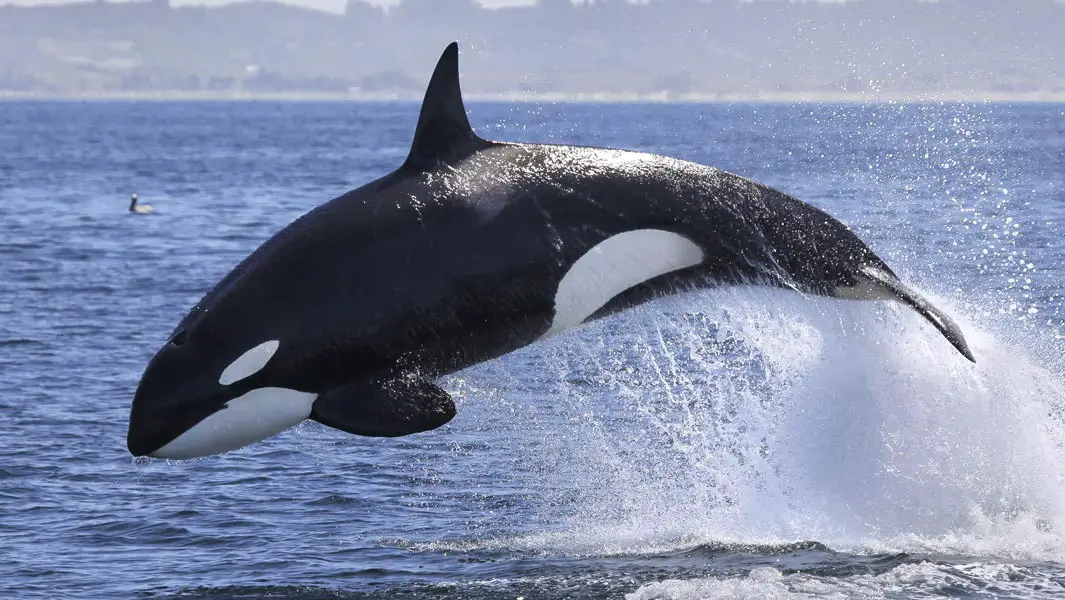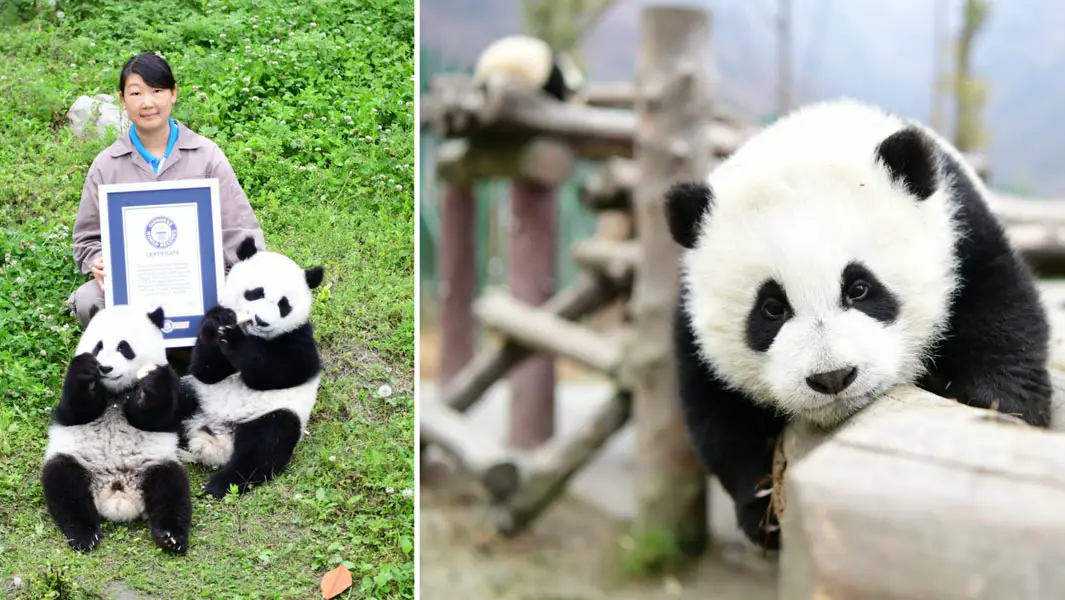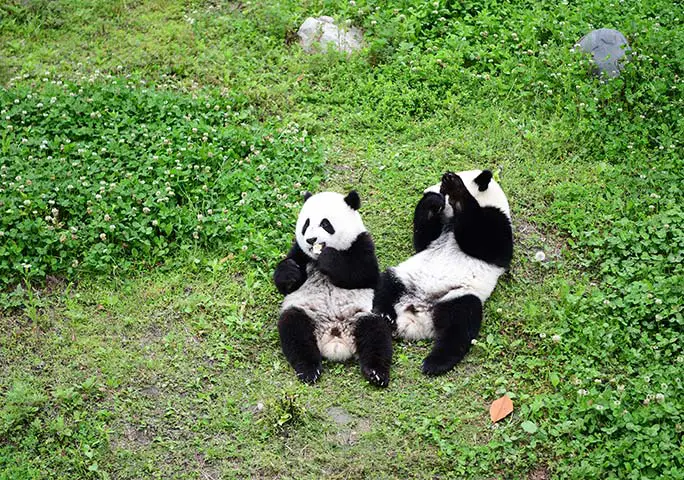


Two giant panda cubs born at Hetaoping Wilderness Training Base in Sichuan Province, China, have unwittingly set a milestone for their threatened species.
He He (“Harmony”) and his sister Mei Mei (“Beautiful”) are the first panda twins with a captive mother and wild father. Born on 25 July 2018, He He arrived at 1.35 p.m. and his sibling followed some four hours later at 5.55 p.m.

Like all giant panda newborns, He He and Mei Mei were hairless and blind. He He tipped the scales at 215 g (7.6 oz), while his smaller sister was a mere 84 g (3 oz) – the average for the species is somewhere between the two at around 150 g (5.3 oz).
Indeed, the size difference between a full-grown giant panda and its tiny infant is a record in its own right. At approximately 1-900th their mother’s weight, these bears are the smallest placental mammal babies relative to adults.
The pair were named after characters in two popular Chinese cartoon series: Krtek a Panda (He He) and Animal Chorus (Mei Mei).
Guinness World Records was delighted to present an official certificate to the cubs – along with one of their carers – to mark this landmark conservation feat in June 2019.

He He and Mei Mei’s now-17-year-old parent Cao Cao – who has been described as a “hero mother” – already had seven offspring to her name. The last of which – a male bear born on 31 July 2017 – was also conceived in the wild, though sadly he passed away within a few months due to illness.
Cao Cao has also previously given birth to two sets of twins, but the fathers of these were, like her, already living within captivity. The latest arrivals’ half-captive-half-wild heritage is what makes this duo record-worthy.

Since 2016, the China Conservation and Research Center for the Giant Panda (CCRCGP), which manages the Hetaoping facility among others, has for brief periods released a handful of females into the forest beyond the confines of the base, in the hope that they would encounter a wild male and breed. This interaction is seen as a vital step to bolster the limited gene pool of the captive panda population, which poses a danger to the bears’ genetic diversity and resilience to disease.
Cao Cao, who herself was born in the wild but has been cared for by humans since she was around 13 months old, is the first known success story from this initiative. Following the tragic death of her half-wild cub in 2017, there is a great sense of joy and relief as the twins approach their first birthday.
As is standard practice for any panda twins born in captivity, keepers and nursery workers were actively involved with the rearing process, performing regular health checks. They ensured that each cub received ample milk and maternal attention by initially swapping out He He and Mei Mei every couple of days to maximize both youngsters’ chances of survival.

A year on, both twins are healthy and developing their life skills at the nearby Shenshuping Panda Base. Here, they are being socialized with other bears of a similar age in a special “panda kindergarten”.
Yu Qiu, the CCRCGP’s Deputy Director of Cultural Promotion told us that the siblings are already exhibiting different personalities: “He He is mild and modest, while Mei Mei is outgoing and naughty and often ‘bullies’ her brother!”
While still being given some formula milk, the cubs are also being introduced to “a small amount of bamboo shoots every day”. Two of the siblings’ favourite activities at the panda playground are playing on the swings and slides.
By summer 2020, the twins will themselves be considered old enough to venture into the wild, but it's unlikely either will be released because their mixed heritage makes them far too valuable to the captive panda gene pool.

Both the Hetaoping and the Shenshuping panda bases are located within the Wolong National Nature Reserve, which itself forms part of the wider Sichuan Giant Panda Sanctuaries complex in south-west China. This contiguous network of protected montane forest, spanning the Jiajin and Qionglai mountain ranges, represents the largest giant panda habitat on Earth. It is home to an estimated 30% of these bears’ total population.
Thanks to a concerted effort by the Chinese government and international wildlife preservation partners, giant panda numbers have seen a rise over the last few decades, up from a low of 1,000 to around 2,200 today. In 2016, their status was downgraded from Endangered to Vulnerable on the IUCN Red List.
While the upward trend is cause for celebration, experts have warned that pandas’ long-term future still balances on a knife-edge. Executive Deputy Director for the CCRCGP, Zhang Hemin, said: “In some places, the wild population is less than 30… If we don’t help them, they’ll be extinct within the next 30–50 years. That’s why we are training the captive-bred pandas for release.
“We hope this will kick-start more efforts of releasing more pandas into the wild in the future.”
How best to assist this iconic species in its recovery remains debated, with different conservation organizations taking different approaches. The Hetaoping Wilderness Training Base, for instance, has opted for minimal contact between humans and pandas – in an effort to make the enclosures as similar to the natural world as possible and to help increase the pandas’ independence.

Indeed, any close-up interaction between staff and the residents at this facility involves the keepers dressing up in black-and-white costumes that are then covered in panda pee in a bid to mask their human scent!
Other panda centres are more hands-on, directly training young cubs survival skills such as how to find water and scale trees. It’s thought that this approach makes it less stressful for pandas when older should humans ever need to step in to assist them because of an injury or illness.
Differing panda-nurture strategies aside, arguably the greatest threat hanging over these mammals is the severe fragmentation of their wild population. Giant pandas are now found in to just three of China’s provinces, compared to 17 historically. In a bid to join up these isolated subpopulations, plans are well underway to establish a 27,133-km2 (10,476-sq-mi) reserve around their existing range, slated to be complete by 2020. The Giant Panda National Park will be almost three times the size of Yellowstone National Park in the USA and, when officially opened, will claim the record for largest giant panda habitat.
Pi Pi (father) and Li Li (mother) at Beijing Zoo, China, welcomed their son, Ming Ming (“Bright”), on 9 September 1963 – the first documented giant panda to be born by captive bears. A year later, he was joined by a sister.

Born in the Wolong National Nature Reserve in 1978, Jia Jia lived to the grand old age of 38, passing away in 2016. She almost doubled the top-end lifespan for wild pandas, who typically live to 15–20. She was a resident at Ocean Park in Aberdeen, Hong Kong, China, where she was transferred in 1999.
There have only ever been four recorded cases of a giant panda mother giving birth to triplets. The latest trio were Ku Ku, Meng Meng and Shuai Shuai, born at Chimelong Paradise park in Guangzhou, China, on 29 July 2014. The cubs all survived and are about to celebrate their fifth birthday.